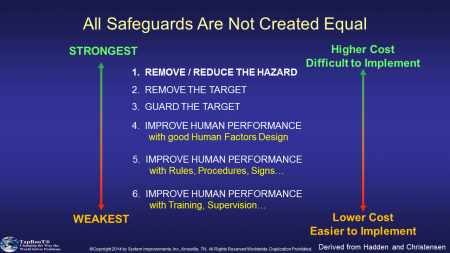The Use of the Safeguard Hierarchy in Healthcare
I often wonder about the thought process that goes into corrective and preventative measures. My gut feeling is that many times we go straight to the same old ideas because they are comfortable, we have knowledge of them due to past use, or simply because they are easy. Whatever the reason, I think we need to remember as TapRooT® users we have many tools at our disposal (SMARTER, Corrective Action Helper®, and Safeguards) to aid us in building better fixes.
A friend told me a story about the death of a relative due to a Unintended Retained Foreign Object (URFO). Due to the object, he ultimately succumbed to an infection and died. So I did some digging and found an article (http://www.beckershospitalreview.com/quality/4-strategies-to-prevent-unintended-retention-of-foreign-object.html) that talked about four strategies from TJC to help reduce URFO’s and started thinking about our Safeguard Hierarchy. When evaluating corrective actions we need to think in terms of protection, protecting the Target from the Hazard. In this case the Target is the Patient and the Hazard is the URFO.
So in line with this, let’s examine our hierarchy of Safeguards and see how it compares to our strategies:

With that in mind let’s look at the 4 strategies proposed by TJC:
Count process: Standardize policies for all procedures, not just those involving an open chest or abdomen. It should be the entire team’s responsibility to reconcile the count. If one member wants the count repeated, the team should comply.
Team communication in the OR: Call out when and instrument is placed in the body cavity and not promptly removed. When a policy deviation occurs, all staff should be capable and comfortable with speaking out and driving issues up the chain of command.
Tools: Items like white boards, sponge trees, radio-frequency identification technology and others should be available whenever invasive procedures are performed. Staff should be held accountable in regards to consistently utilizing these tools.
Standardize the layout: The physical space of a procedural areas should be as close to replicable as possible. While locations may vary, the equipment available should be consistent. Also, cap the number of people allowed in the procedure room. An excess of individuals in the procedural space can increase noise levels, alter visibility and ultimately distract staff.
With a simple analysis we can squarely see that these all fall within the scope of items 4-6 on the Safeguard list above with two of the recommendations falling within the scope of #4 (Standardize the layout) which deals with workspace design. The other two deal with standards and policies for both communication and the process for counting. Even one of the items (Tools) is a crossover action between standards and policies and holding folks accountable. So truly we are 1.5 actions dealing with the workspace, and 2.5 dealing with policies and procedures.
One thing that is a common thread amongst all these items is that they all depend on Human Performance to be truly effective. And although we do not want to see it or believe it, this is the weakest of all safeguards, the reliance on people. But, the fact is, our caregivers are ultimately responsible. Is it any wonder that we see the following comments regarding URFO’s?
While the frequency of URFOs dipped in 2013 after holding the No. 1 position of most frequently reported sentinel event in 2011 and 2012, the numbers trended upward in 2014 and in 2015 they emerged again as the most frequently reported sentinel event.
When we implement safeguards near the bottom of the safeguard hierarchy they will quickly raise the awareness on the issue, thus the dip in URFO’s, but over time they will not be effective (alone or in part) in truly changing the behaviors that cause these issues. We need to shift our focus to the top of the hierarchy if at all possible to truly impact performance.
If topics like this interest you, I’m leading a medical track at the 2016 Global TapRooT® Summit. Breakout sessions include:
- 7 Deadly Sins of Human Performance
- TapRooT® Changes for the Medical Community
- Human Error Causes of Quality Problems
- Writing TapRooT® Driven Preventative & Corrective Actions Workshop
- Anatomy of a Medical Investigation & more!
GO HERE to view or download a .pdf brochure.



